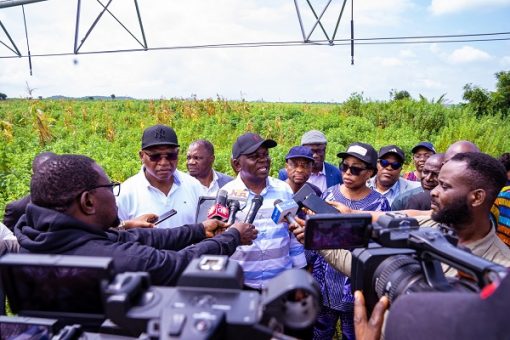
FG revisits abandoned Ogun irrigation project nine years later
The Federal Government has stated that the completion of the Middle Ogun Irrigation Project will create significant employment opportunities, with some 8,000 women and adolescents benefiting from direct jobs and millions more potentially produced indirectly. This is about nine years after the project was abandoned.
In addition, the government said that in addition to creating jobs, the project will strengthen Nigeria's economy by guaranteeing that the country produces enough food to feed its people.
During an on-site evaluation of the project site's amenities, Professor Joseph Utsve, the Minister of Water Resources and Sanitation, gave a speech.
In order to increase food production in the nation, he reiterated the FG's commitment to finishing the irrigation project in the Iseyin local government area in Oyo state.
About nine years after it was shelved, the Federal Government under President Tinubu is giving it another look.
Water from the Ikere-Gorge Dam will be used for irrigation on some 12,000 hectares of farmlands as part of this project, which was awarded in 1990.
Three phases of 4,000 hectares each were used in the project's design. But financial limitations have impeded growth, bringing everything to a halt since 2015.
According to the Minister, the project adheres to President Bola Tinubu's Renewed Hope Agenda.
stating that when revived, will increase food production, generate employment, and bolster the economy of the country.
The Minister declared that irrigation systems will henceforth be powered by a combination of solar energy and the national grid, a dramatic departure from the original intentions.
He claimed that this shift is a reaction to the harsh realities of the economy as well as an adjustment to the urgent threats posed by climate change.
Professor Utsve said, "We have purchased the equipment for the national grid installation, and as of right now, we are almost at 95 percent completion for the grid connection, while the solarisation is approaching 80 percent completion."
He underlined that in order to maximise the project's potential and efficiency, the remaining procurement must be finalised as quickly as possible.
"There will likely be a significant increase in employment after the Middle Ogun Irrigation Project is completed. A little over 8,000 women and young people will gain from direct employment, and millions more may be generated indirectly.
The Minister continued, "By doing this, we can ensure maximum food production to serve Nigerians, create jobs, and enhance this country's economy."
In response to a question concerning the completion schedule, Professor Utsve promised that the solar panel installation will be finished by the end of this year, and that the irrigation facilities will thereafter be restored.
He estimated that all 12,000 hectares of land intended for agriculture will be completely functional in two to three years.
The Minister declared that irrigation systems will henceforth be powered by a combination of solar energy and the national grid, a dramatic departure from the original intentions.
He claimed that this shift is a reaction to the harsh realities of the economy as well as an adjustment to the urgent threats posed by climate change.
Professor Utsve said, "We have purchased the equipment for the national grid installation, and as of right now, we are almost at 95 percent completion for the grid connection, while the solarisation is approaching 80 percent completion."
He underlined that in order to maximise the project's potential and efficiency, the remaining procurement must be finalised as quickly as possible.
"There will likely be a significant increase in employment after the Middle Ogun Irrigation Project is completed. A little over 8,000 women and young people will gain from direct employment, and millions more may be generated indirectly.
The Minister continued, "By doing this, we can ensure maximum food production to serve Nigerians, create jobs, and enhance this country's economy."
Regarding the completion schedule, Professor Utsve promised that by the end of this year, the installation of solar panels will be complete, followed by the rehabilitation of irrigation facilities.
He estimated that all 12,000 hectares of land intended for agriculture will be completely functional in two to three years.





